Examining Ethics: An In-depth Analysis of ISO/IEC/IEEE 12207:2017
VerifiedAdded on 2023/06/08
|6
|1617
|211
Report
AI Summary
This report provides an overview of the ISO/IEC/IEEE 12207:2017 international standard for software lifecycle processes, focusing on its role in ensuring ethical conduct and quality in software development and maintenance. It outlines the standard's attributes, broad applications, and its impact on various aspects of software engineering, including user certification, process evaluation, and world trade. The report also discusses the application of ISO/IEC 12207:2017 in product or service systems, particularly within organizations like JP Morgan Chase, and its relevance to software process improvement (SPI) and the integration of agile methods. The document highlights the importance of process optimization and the challenges faced by SMEs in adopting and implementing these standards, emphasizing the need for vibrant process ability in software development organizations. This student assignment is available on Desklib, a platform offering a wealth of study resources for students.
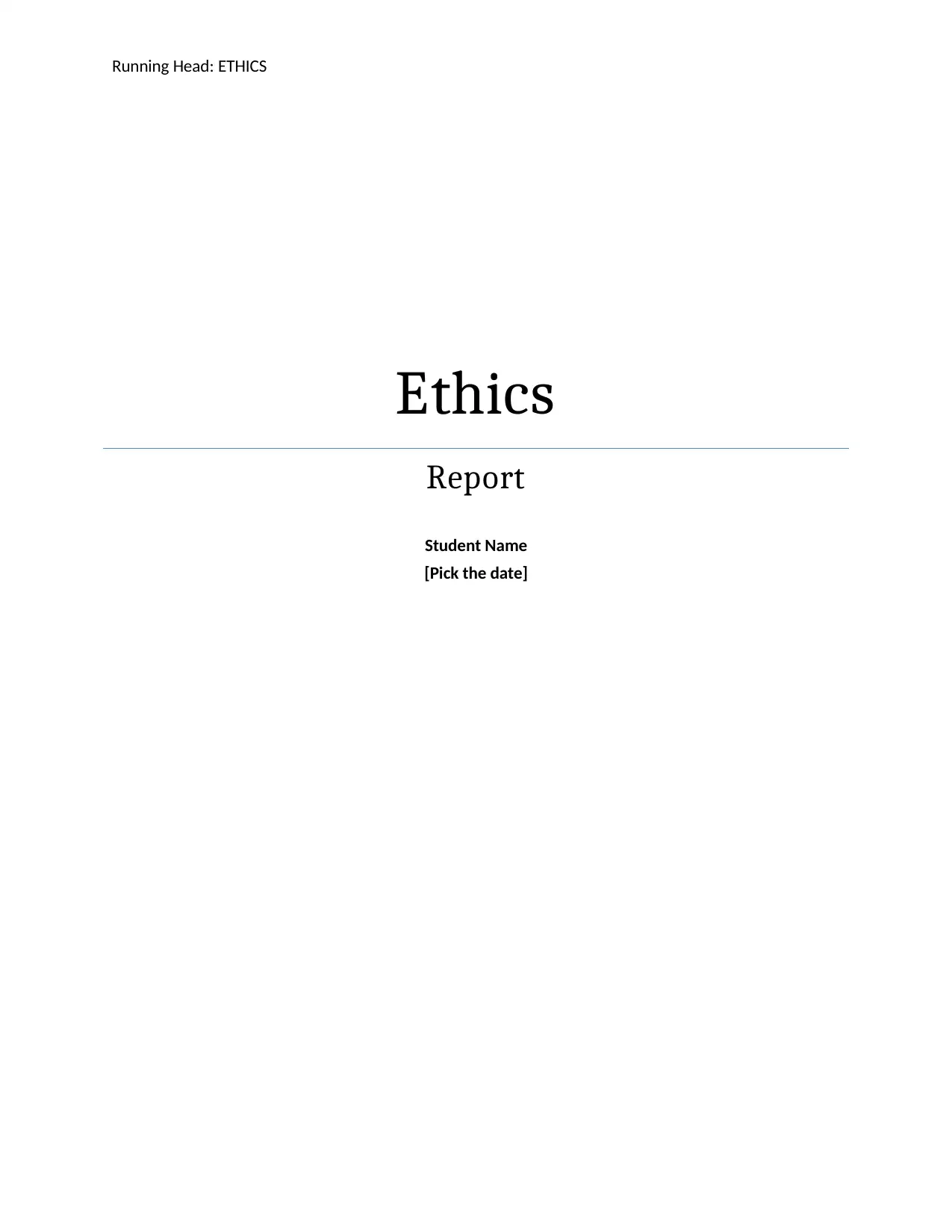
Running Head: ETHICS
Ethics
Report
Student Name
[Pick the date]
Ethics
Report
Student Name
[Pick the date]
Paraphrase This Document
Need a fresh take? Get an instant paraphrase of this document with our AI Paraphraser
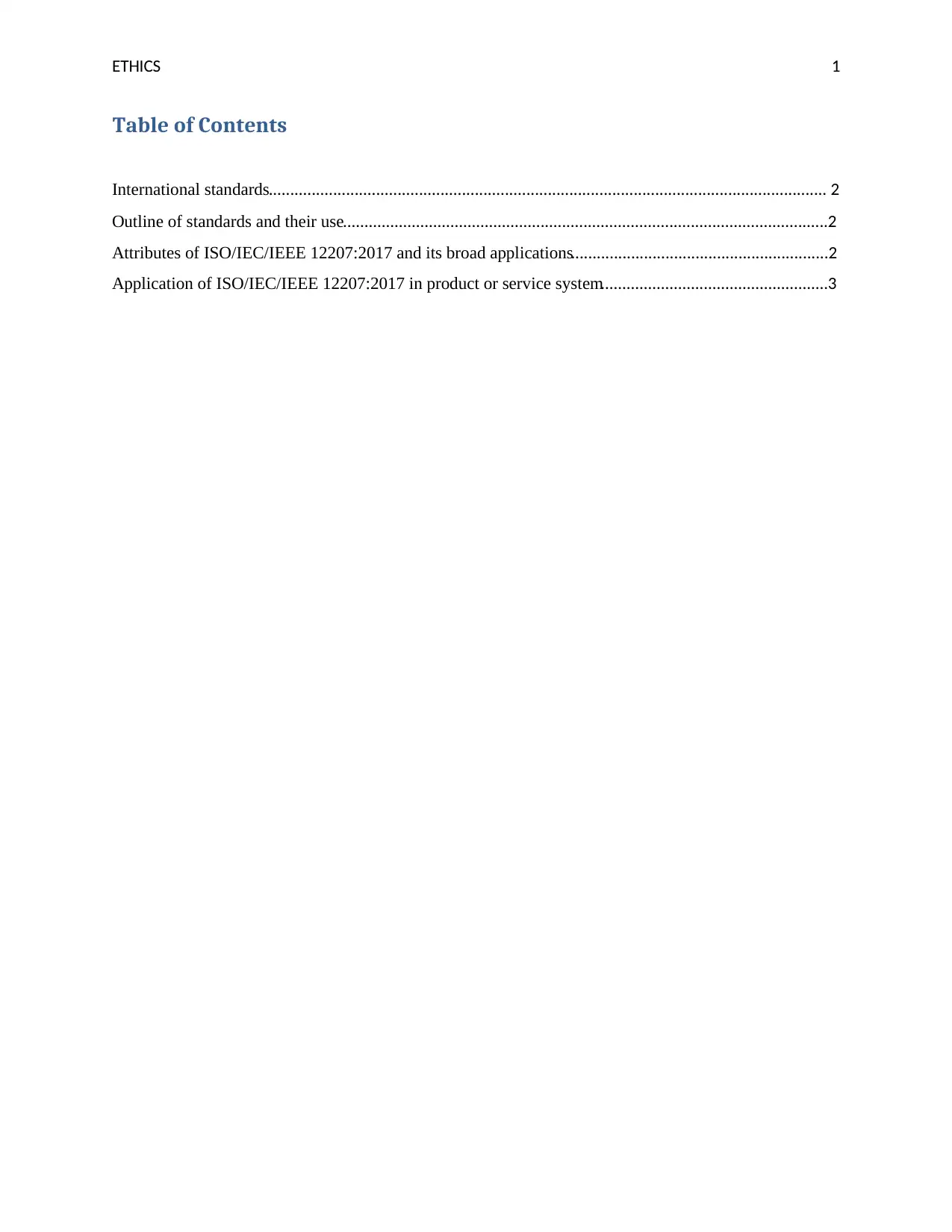
ETHICS 1
Table of Contents
International standards.................................................................................................................................. 2
Outline of standards and their use.................................................................................................................2
Attributes of ISO/IEC/IEEE 12207:2017 and its broad applications............................................................2
Application of ISO/IEC/IEEE 12207:2017 in product or service system.....................................................3
Table of Contents
International standards.................................................................................................................................. 2
Outline of standards and their use.................................................................................................................2
Attributes of ISO/IEC/IEEE 12207:2017 and its broad applications............................................................2
Application of ISO/IEC/IEEE 12207:2017 in product or service system.....................................................3
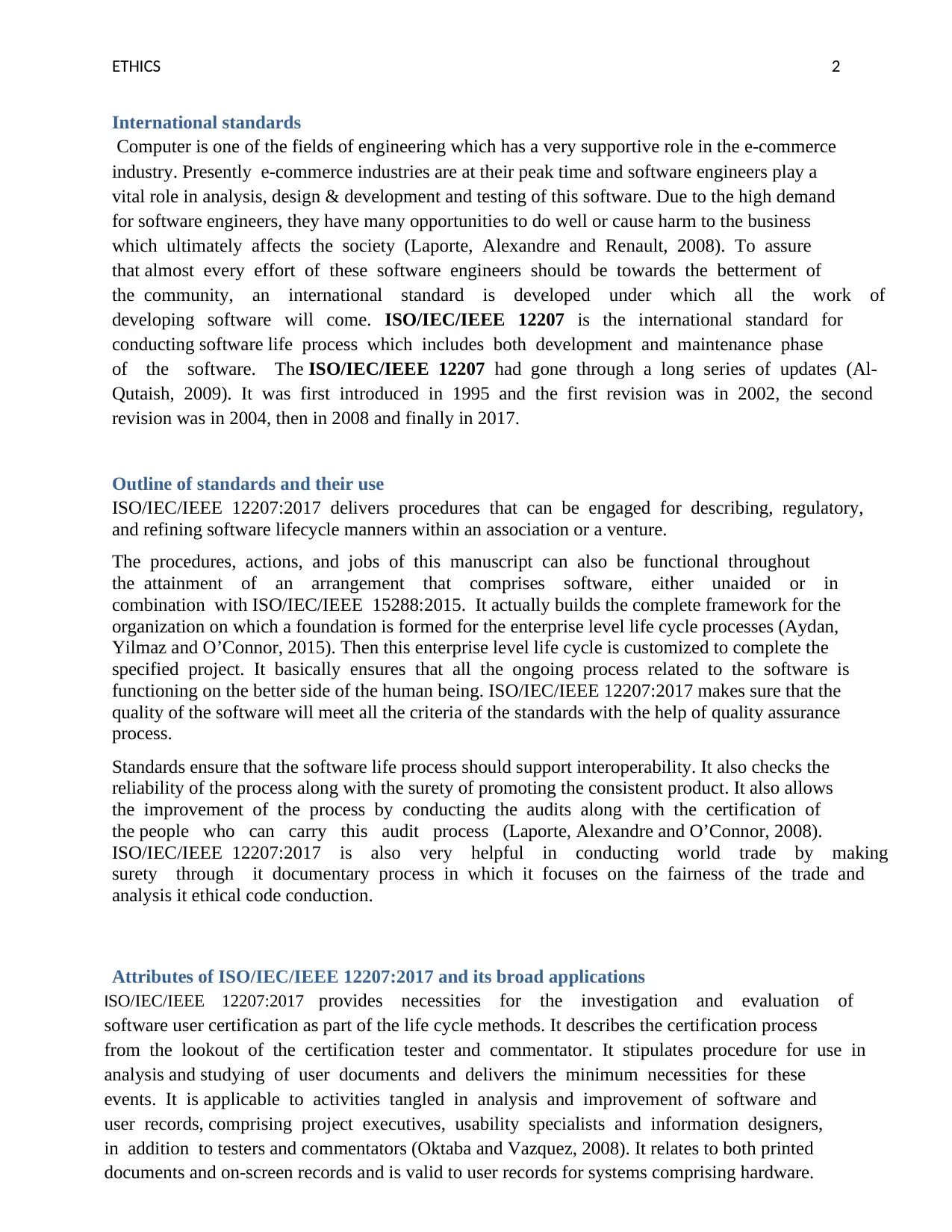
ETHICS 2
International standards
Computer is one of the fields of engineering which has a very supportive role in the e-commerce
industry. Presently e-commerce industries are at their peak time and software engineers play a
vital role in analysis, design & development and testing of this software. Due to the high demand
for software engineers, they have many opportunities to do well or cause harm to the business
which ultimately affects the society (Laporte, Alexandre and Renault, 2008). To assure
that almost every effort of these software engineers should be towards the betterment of
the community, an international standard is developed under which all the work of
developing software will come. ISO/IEC/IEEE 12207 is the international standard for
conducting software life process which includes both development and maintenance phase
of the software. The ISO/IEC/IEEE 12207 had gone through a long series of updates (Al-
Qutaish, 2009). It was first introduced in 1995 and the first revision was in 2002, the second
revision was in 2004, then in 2008 and finally in 2017.
Outline of standards and their use
ISO/IEC/IEEE 12207:2017 delivers procedures that can be engaged for describing, regulatory,
and refining software lifecycle manners within an association or a venture.
The procedures, actions, and jobs of this manuscript can also be functional throughout
the attainment of an arrangement that comprises software, either unaided or in
combination with ISO/IEC/IEEE 15288:2015. It actually builds the complete framework for the
organization on which a foundation is formed for the enterprise level life cycle processes (Aydan,
Yilmaz and O’Connor, 2015). Then this enterprise level life cycle is customized to complete the
specified project. It basically ensures that all the ongoing process related to the software is
functioning on the better side of the human being. ISO/IEC/IEEE 12207:2017 makes sure that the
quality of the software will meet all the criteria of the standards with the help of quality assurance
process.
Standards ensure that the software life process should support interoperability. It also checks the
reliability of the process along with the surety of promoting the consistent product. It also allows
the improvement of the process by conducting the audits along with the certification of
the people who can carry this audit process (Laporte, Alexandre and O’Connor, 2008).
ISO/IEC/IEEE 12207:2017 is also very helpful in conducting world trade by making
surety through it documentary process in which it focuses on the fairness of the trade and
analysis it ethical code conduction.
Attributes of ISO/IEC/IEEE 12207:2017 and its broad applications
ISO/IEC/IEEE 12207:2017 provides necessities for the investigation and evaluation of
software user certification as part of the life cycle methods. It describes the certification process
from the lookout of the certification tester and commentator. It stipulates procedure for use in
analysis and studying of user documents and delivers the minimum necessities for these
events. It is applicable to activities tangled in analysis and improvement of software and
user records, comprising project executives, usability specialists and information designers,
in addition to testers and commentators (Oktaba and Vazquez, 2008). It relates to both printed
documents and on-screen records and is valid to user records for systems comprising hardware.
International standards
Computer is one of the fields of engineering which has a very supportive role in the e-commerce
industry. Presently e-commerce industries are at their peak time and software engineers play a
vital role in analysis, design & development and testing of this software. Due to the high demand
for software engineers, they have many opportunities to do well or cause harm to the business
which ultimately affects the society (Laporte, Alexandre and Renault, 2008). To assure
that almost every effort of these software engineers should be towards the betterment of
the community, an international standard is developed under which all the work of
developing software will come. ISO/IEC/IEEE 12207 is the international standard for
conducting software life process which includes both development and maintenance phase
of the software. The ISO/IEC/IEEE 12207 had gone through a long series of updates (Al-
Qutaish, 2009). It was first introduced in 1995 and the first revision was in 2002, the second
revision was in 2004, then in 2008 and finally in 2017.
Outline of standards and their use
ISO/IEC/IEEE 12207:2017 delivers procedures that can be engaged for describing, regulatory,
and refining software lifecycle manners within an association or a venture.
The procedures, actions, and jobs of this manuscript can also be functional throughout
the attainment of an arrangement that comprises software, either unaided or in
combination with ISO/IEC/IEEE 15288:2015. It actually builds the complete framework for the
organization on which a foundation is formed for the enterprise level life cycle processes (Aydan,
Yilmaz and O’Connor, 2015). Then this enterprise level life cycle is customized to complete the
specified project. It basically ensures that all the ongoing process related to the software is
functioning on the better side of the human being. ISO/IEC/IEEE 12207:2017 makes sure that the
quality of the software will meet all the criteria of the standards with the help of quality assurance
process.
Standards ensure that the software life process should support interoperability. It also checks the
reliability of the process along with the surety of promoting the consistent product. It also allows
the improvement of the process by conducting the audits along with the certification of
the people who can carry this audit process (Laporte, Alexandre and O’Connor, 2008).
ISO/IEC/IEEE 12207:2017 is also very helpful in conducting world trade by making
surety through it documentary process in which it focuses on the fairness of the trade and
analysis it ethical code conduction.
Attributes of ISO/IEC/IEEE 12207:2017 and its broad applications
ISO/IEC/IEEE 12207:2017 provides necessities for the investigation and evaluation of
software user certification as part of the life cycle methods. It describes the certification process
from the lookout of the certification tester and commentator. It stipulates procedure for use in
analysis and studying of user documents and delivers the minimum necessities for these
events. It is applicable to activities tangled in analysis and improvement of software and
user records, comprising project executives, usability specialists and information designers,
in addition to testers and commentators (Oktaba and Vazquez, 2008). It relates to both printed
documents and on-screen records and is valid to user records for systems comprising hardware.
⊘ This is a preview!⊘
Do you want full access?
Subscribe today to unlock all pages.

Trusted by 1+ million students worldwide
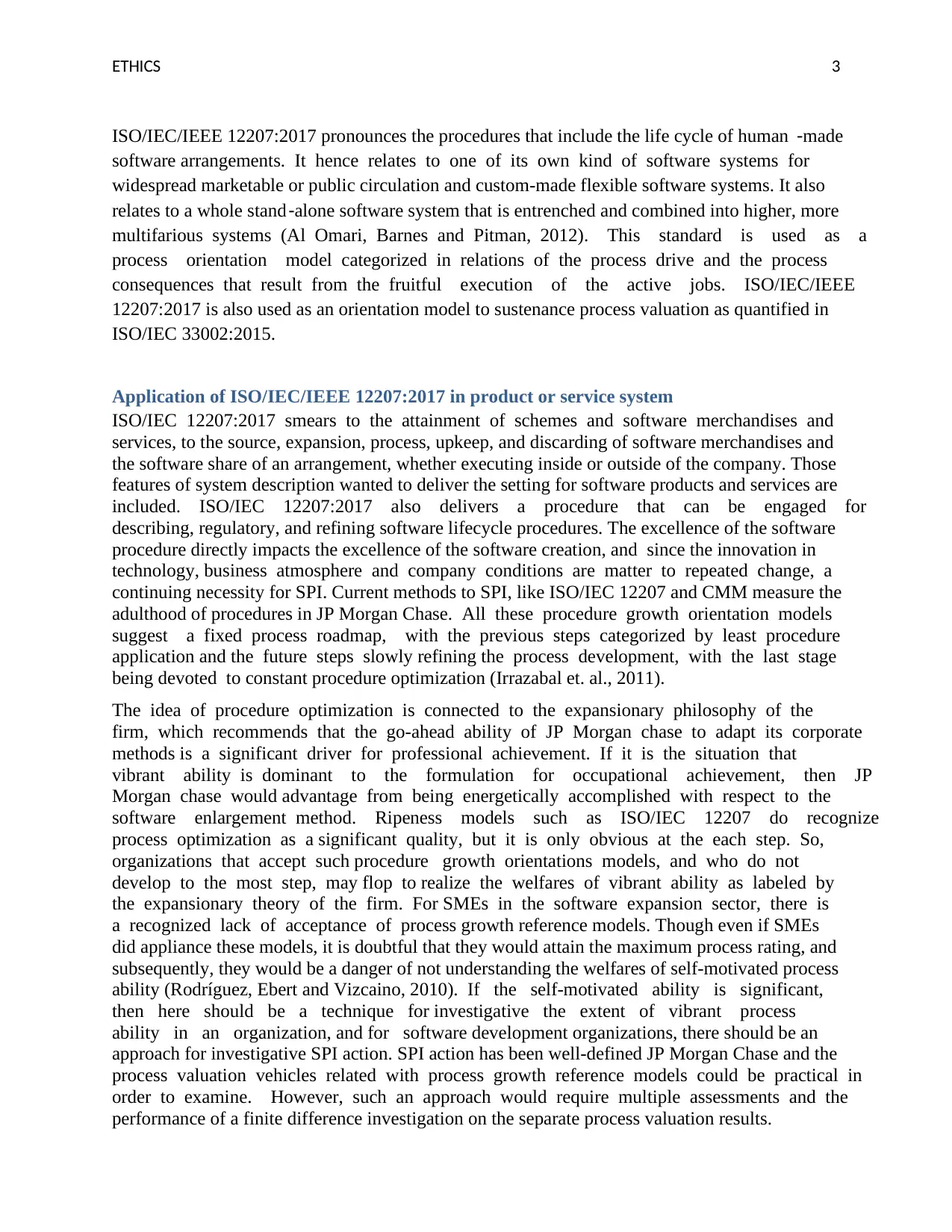
ETHICS 3
ISO/IEC/IEEE 12207:2017 pronounces the procedures that include the life cycle of human ‐made
software arrangements. It hence relates to one of its own kind of software systems for
widespread marketable or public circulation and custom-made flexible software systems. It also
relates to a whole stand‐alone software system that is entrenched and combined into higher, more
multifarious systems (Al Omari, Barnes and Pitman, 2012). This standard is used as a
process orientation model categorized in relations of the process drive and the process
consequences that result from the fruitful execution of the active jobs. ISO/IEC/IEEE
12207:2017 is also used as an orientation model to sustenance process valuation as quantified in
ISO/IEC 33002:2015.
Application of ISO/IEC/IEEE 12207:2017 in product or service system
ISO/IEC 12207:2017 smears to the attainment of schemes and software merchandises and
services, to the source, expansion, process, upkeep, and discarding of software merchandises and
the software share of an arrangement, whether executing inside or outside of the company. Those
features of system description wanted to deliver the setting for software products and services are
included. ISO/IEC 12207:2017 also delivers a procedure that can be engaged for
describing, regulatory, and refining software lifecycle procedures. The excellence of the software
procedure directly impacts the excellence of the software creation, and since the innovation in
technology, business atmosphere and company conditions are matter to repeated change, a
continuing necessity for SPI. Current methods to SPI, like ISO/IEC 12207 and CMM measure the
adulthood of procedures in JP Morgan Chase. All these procedure growth orientation models
suggest a fixed process roadmap, with the previous steps categorized by least procedure
application and the future steps slowly refining the process development, with the last stage
being devoted to constant procedure optimization (Irrazabal et. al., 2011).
The idea of procedure optimization is connected to the expansionary philosophy of the
firm, which recommends that the go-ahead ability of JP Morgan chase to adapt its corporate
methods is a significant driver for professional achievement. If it is the situation that
vibrant ability is dominant to the formulation for occupational achievement, then JP
Morgan chase would advantage from being energetically accomplished with respect to the
software enlargement method. Ripeness models such as ISO/IEC 12207 do recognize
process optimization as a significant quality, but it is only obvious at the each step. So,
organizations that accept such procedure growth orientations models, and who do not
develop to the most step, may flop to realize the welfares of vibrant ability as labeled by
the expansionary theory of the firm. For SMEs in the software expansion sector, there is
a recognized lack of acceptance of process growth reference models. Though even if SMEs
did appliance these models, it is doubtful that they would attain the maximum process rating, and
subsequently, they would be a danger of not understanding the welfares of self-motivated process
ability (Rodríguez, Ebert and Vizcaino, 2010). If the self-motivated ability is significant,
then here should be a technique for investigative the extent of vibrant process
ability in an organization, and for software development organizations, there should be an
approach for investigative SPI action. SPI action has been well-defined JP Morgan Chase and the
process valuation vehicles related with process growth reference models could be practical in
order to examine. However, such an approach would require multiple assessments and the
performance of a finite difference investigation on the separate process valuation results.
ISO/IEC/IEEE 12207:2017 pronounces the procedures that include the life cycle of human ‐made
software arrangements. It hence relates to one of its own kind of software systems for
widespread marketable or public circulation and custom-made flexible software systems. It also
relates to a whole stand‐alone software system that is entrenched and combined into higher, more
multifarious systems (Al Omari, Barnes and Pitman, 2012). This standard is used as a
process orientation model categorized in relations of the process drive and the process
consequences that result from the fruitful execution of the active jobs. ISO/IEC/IEEE
12207:2017 is also used as an orientation model to sustenance process valuation as quantified in
ISO/IEC 33002:2015.
Application of ISO/IEC/IEEE 12207:2017 in product or service system
ISO/IEC 12207:2017 smears to the attainment of schemes and software merchandises and
services, to the source, expansion, process, upkeep, and discarding of software merchandises and
the software share of an arrangement, whether executing inside or outside of the company. Those
features of system description wanted to deliver the setting for software products and services are
included. ISO/IEC 12207:2017 also delivers a procedure that can be engaged for
describing, regulatory, and refining software lifecycle procedures. The excellence of the software
procedure directly impacts the excellence of the software creation, and since the innovation in
technology, business atmosphere and company conditions are matter to repeated change, a
continuing necessity for SPI. Current methods to SPI, like ISO/IEC 12207 and CMM measure the
adulthood of procedures in JP Morgan Chase. All these procedure growth orientation models
suggest a fixed process roadmap, with the previous steps categorized by least procedure
application and the future steps slowly refining the process development, with the last stage
being devoted to constant procedure optimization (Irrazabal et. al., 2011).
The idea of procedure optimization is connected to the expansionary philosophy of the
firm, which recommends that the go-ahead ability of JP Morgan chase to adapt its corporate
methods is a significant driver for professional achievement. If it is the situation that
vibrant ability is dominant to the formulation for occupational achievement, then JP
Morgan chase would advantage from being energetically accomplished with respect to the
software enlargement method. Ripeness models such as ISO/IEC 12207 do recognize
process optimization as a significant quality, but it is only obvious at the each step. So,
organizations that accept such procedure growth orientations models, and who do not
develop to the most step, may flop to realize the welfares of vibrant ability as labeled by
the expansionary theory of the firm. For SMEs in the software expansion sector, there is
a recognized lack of acceptance of process growth reference models. Though even if SMEs
did appliance these models, it is doubtful that they would attain the maximum process rating, and
subsequently, they would be a danger of not understanding the welfares of self-motivated process
ability (Rodríguez, Ebert and Vizcaino, 2010). If the self-motivated ability is significant,
then here should be a technique for investigative the extent of vibrant process
ability in an organization, and for software development organizations, there should be an
approach for investigative SPI action. SPI action has been well-defined JP Morgan Chase and the
process valuation vehicles related with process growth reference models could be practical in
order to examine. However, such an approach would require multiple assessments and the
performance of a finite difference investigation on the separate process valuation results.
Paraphrase This Document
Need a fresh take? Get an instant paraphrase of this document with our AI Paraphraser
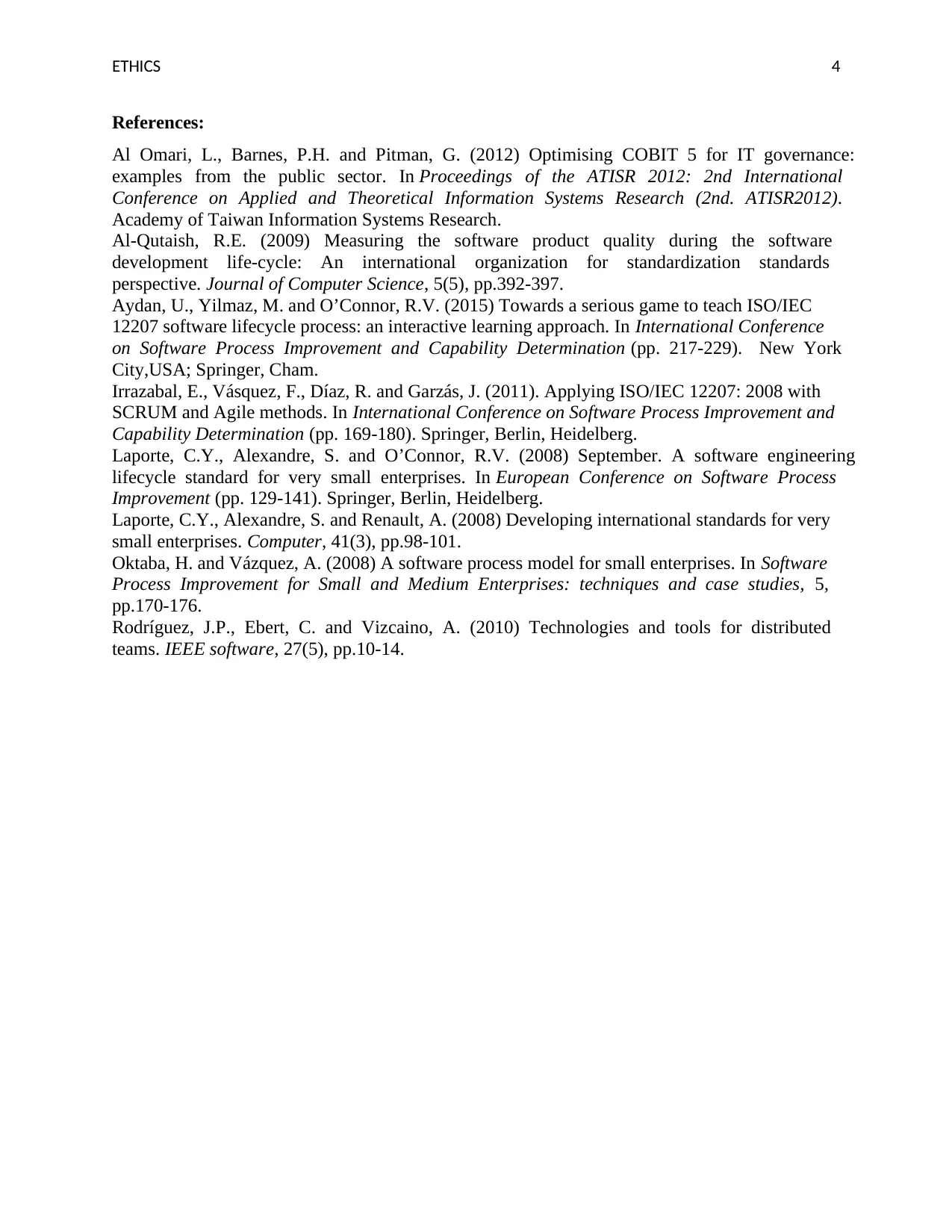
ETHICS 4
References:
Al Omari, L., Barnes, P.H. and Pitman, G. (2012) Optimising COBIT 5 for IT governance:
examples from the public sector. In Proceedings of the ATISR 2012: 2nd International
Conference on Applied and Theoretical Information Systems Research (2nd. ATISR2012).
Academy of Taiwan Information Systems Research.
Al-Qutaish, R.E. (2009) Measuring the software product quality during the software
development life-cycle: An international organization for standardization standards
perspective. Journal of Computer Science, 5(5), pp.392-397.
Aydan, U., Yilmaz, M. and O’Connor, R.V. (2015) Towards a serious game to teach ISO/IEC
12207 software lifecycle process: an interactive learning approach. In International Conference
on Software Process Improvement and Capability Determination (pp. 217-229). New York
City,USA; Springer, Cham.
Irrazabal, E., Vásquez, F., Díaz, R. and Garzás, J. (2011). Applying ISO/IEC 12207: 2008 with
SCRUM and Agile methods. In International Conference on Software Process Improvement and
Capability Determination (pp. 169-180). Springer, Berlin, Heidelberg.
Laporte, C.Y., Alexandre, S. and O’Connor, R.V. (2008) September. A software engineering
lifecycle standard for very small enterprises. In European Conference on Software Process
Improvement (pp. 129-141). Springer, Berlin, Heidelberg.
Laporte, C.Y., Alexandre, S. and Renault, A. (2008) Developing international standards for very
small enterprises. Computer, 41(3), pp.98-101.
Oktaba, H. and Vázquez, A. (2008) A software process model for small enterprises. In Software
Process Improvement for Small and Medium Enterprises: techniques and case studies, 5,
pp.170-176.
Rodríguez, J.P., Ebert, C. and Vizcaino, A. (2010) Technologies and tools for distributed
teams. IEEE software, 27(5), pp.10-14.
References:
Al Omari, L., Barnes, P.H. and Pitman, G. (2012) Optimising COBIT 5 for IT governance:
examples from the public sector. In Proceedings of the ATISR 2012: 2nd International
Conference on Applied and Theoretical Information Systems Research (2nd. ATISR2012).
Academy of Taiwan Information Systems Research.
Al-Qutaish, R.E. (2009) Measuring the software product quality during the software
development life-cycle: An international organization for standardization standards
perspective. Journal of Computer Science, 5(5), pp.392-397.
Aydan, U., Yilmaz, M. and O’Connor, R.V. (2015) Towards a serious game to teach ISO/IEC
12207 software lifecycle process: an interactive learning approach. In International Conference
on Software Process Improvement and Capability Determination (pp. 217-229). New York
City,USA; Springer, Cham.
Irrazabal, E., Vásquez, F., Díaz, R. and Garzás, J. (2011). Applying ISO/IEC 12207: 2008 with
SCRUM and Agile methods. In International Conference on Software Process Improvement and
Capability Determination (pp. 169-180). Springer, Berlin, Heidelberg.
Laporte, C.Y., Alexandre, S. and O’Connor, R.V. (2008) September. A software engineering
lifecycle standard for very small enterprises. In European Conference on Software Process
Improvement (pp. 129-141). Springer, Berlin, Heidelberg.
Laporte, C.Y., Alexandre, S. and Renault, A. (2008) Developing international standards for very
small enterprises. Computer, 41(3), pp.98-101.
Oktaba, H. and Vázquez, A. (2008) A software process model for small enterprises. In Software
Process Improvement for Small and Medium Enterprises: techniques and case studies, 5,
pp.170-176.
Rodríguez, J.P., Ebert, C. and Vizcaino, A. (2010) Technologies and tools for distributed
teams. IEEE software, 27(5), pp.10-14.

ETHICS 5
⊘ This is a preview!⊘
Do you want full access?
Subscribe today to unlock all pages.

Trusted by 1+ million students worldwide
1 out of 6
Related Documents
Your All-in-One AI-Powered Toolkit for Academic Success.
+13062052269
info@desklib.com
Available 24*7 on WhatsApp / Email
![[object Object]](/_next/static/media/star-bottom.7253800d.svg)
Unlock your academic potential
Copyright © 2020–2025 A2Z Services. All Rights Reserved. Developed and managed by ZUCOL.


